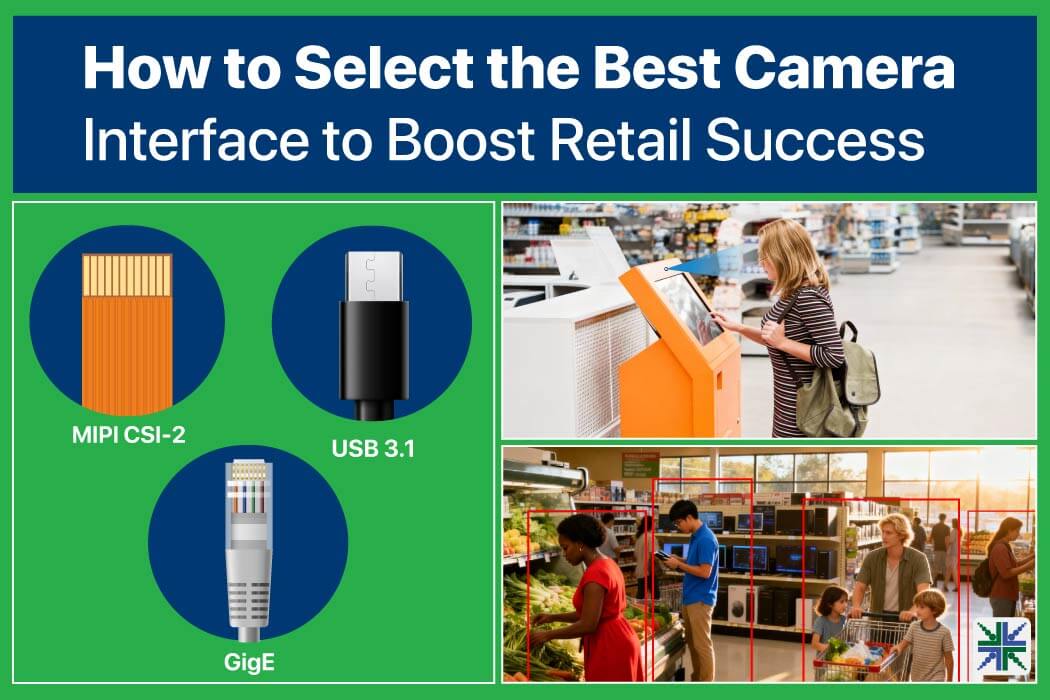What you will learn:
- How interface characteristics influence latency, resolution, and cable reach
- Factors that shape deployment choices in different retail setups
- Practical criteria to align interfaces with workflow requirements and store formats
- The role of connectivity in scaling retail vision systems
Retail spaces are becoming increasingly reliant on embedded vision to manage checkout, monitor shelf inventory, and observe shopper behavior. One of the critical decisions to be taken is the choice of camera interface.
Choosing the wrong interface can result in bottlenecks in data handling, compatibility limitations, or image quality issues. The right one, however, ensures that the retail camera application performs exceptionally well across its service life.
In this blog, you’ll get expert insights into camera interfaces in retail environments and how to select the best-fit interface for your application.
Why Camera Interfaces Matter to Retail Applications
The camera interface governs how video data is transmitted from the sensor to the processor or server. This plays a direct role in shaping the camera’s performance in the store environment. Each interface offers a different combination of bandwidth, cable reach, system complexity, and host support.
In practical terms, it affects everything from how quickly a face can be recognized at a self-checkout station to how reliably product engagement is recorded in front of a digital shelf.
Key considerations:
- Distance between the camera and the processing unit
- Type of image data (compressed or uncompressed)
- Frame rate and resolution expectations
- Integration with embedded AI modules or edge devices
- Power supply options and deployment environment
Top 3 Camera Interfaces for Retail Settings
USB 3.1
USB 3.1 continues to be a leading choice for many retail deployments. Its plug-and-play nature enables rapid integration into standard embedded systems across operating platforms such as Linux, Android, and Windows. The interface supports high data throughput, making it suitable for full HD and 4K imaging applications within limited space installations. It is especially compatible with self-checkout kiosks, interactive advertising systems, and self-checkout or loss prevention table-top devices that operate in close proximity to their processing units.
Typical cable lengths remain within a 3-meter range, which aligns well with countertop or in-wall camera placements. Due to its ubiquity, USB 3.1 cameras require minimal hardware-level debugging, reducing deployment overhead.
A wide ecosystem of host processors and off-the-shelf modules is already available with USB 3.1 support, which also helps in scaling up operations across multiple store locations.
MIPI CSI-2
MIPI CSI-2 is a high-speed interface for direct sensor-to-processor transmission in compact embedded systems. Its design favors tightly integrated environments where the camera and processing board are housed within the same enclosure. Since MIPI CSI-2 supports multi-lane configurations, the interface can handle large volumes of raw image data while minimizing latency.
In retail settings, it excels when paired with processors like the NVIDIA Jetson series or Qualcomm Snapdragon platforms, powering applications like smart vending kiosks. MIPI CSI-2 also supports frame-level synchronization, making it useful in stereo or multi-angle vision configurations used for depth sensing or object tracking.
GigE
Gigabit Ethernet, or GigE, provides long-distance, high-bandwidth connectivity over standard Cat5e/Cat6 cables. It offers support for extended cable lengths (up to 100 m) and can handle uncompressed video streams with high frame rates. So, it is very useful in environments where cameras are distributed across large floor areas or need to feed video into centralized processing hubs.
GigE also supports multi-camera synchronization and time-stamping in applications involving queue tracking, full-store behavioral analytics, or large-scale facial recognition deployments. With integration with Power over Ethernet (PoE), installation can be further simplified through a single cable.
Find the Best Retail Camera Interface: Factors to Consider
When to Select USB 3.1
USB 3.1 is ideal when your deployment involves short cable runs and standard computing platforms. Choose this interface if the system architecture depends on off-the-shelf embedded boards and the camera must deliver high-quality video without requiring external frame grabbers or host customization.
Consider USB 3.1 for:
- Small-format kiosks and digital signages with limited wiring complexity
- Counter-mounted self-checkout systems
- Self-checkout table-top devices
These environments benefit from the USB protocol’s stability and compatibility with general-purpose processors. USB 3.1 also offers an excellent pathway for integrating with cloud platforms where captured data is uploaded periodically rather than analyzed at the edge.
When to Select MIPI CSI-2
MIPI CSI-2 becomes the interface of choice when the camera and processor are installed within the same housing, and the application demands real-time image processing. It applies to embedded vision devices that operate continuously and run deep learning models directly on the processor.
Use MIPI CSI-2 when:
- Edge AI modules are embedded into smart kiosks
- Cameras must maintain a small footprint and also support higher bandwidth and low latency
These characteristics make MIPI CSI-2 suited for tightly integrated systems where space, weight, and latency constraints drive hardware design. Remember that the interface is purpose-built for direct integration into SOCs with no need for additional interface bridges.
When to Select GigE
GigE should be selected in cases where distributed camera placements are required, especially in large-format retail stores. It works great in settings where the host/server is centralized and cameras are installed in multiple areas where longer cabling is required. It is also useful for delivering high-fidelity videos for batch processing, anomaly detection, or real-time analytics.
Adopt GigE in scenarios such as:
- Monitoring entrances and exits from a central control room
- Enabling drive-through devices to communicate the order
- Capturing wide-angle footage across warehouse-style retail spaces
- Feeding data from multiple cameras into a single edge server (For instance, this helps capture retail customer analytics inside a store to track footfall or loss prevention.)
GigE also supports configurations involving time-critical image capture, such as synchronized multi-camera recordings across different parts of the store. It becomes the most viable option if your store requires higher data integrity across longer transmission distances.
e-con Systems’ Cameras are Powering Retail Applications Globally
Since 2003, e-con Systems has been designing, developing, and manufacturing OEM cameras. Over the years, we have worked closely to help our retail clients across the world find the best-suited imaging solution for their retail applications. We offer retail cameras with interfaces like GigE, MIPI CS-2, and USB 3.1 and are equipped with features such as:
- Onboard ISP
- Superior low-light performance
- Minimal noise
- LED flicker mitigation
- Two-way control
- Long transmission distances.
- Support for object detection and recognition
Our cameras are also compatible with computing platforms like NVIDIA, Qualcomm, NXP, Ambarella, and x86.
See how our retail cameras can help you.
Explore our Camera Selector Page to view our full portfolio.
Please write to camerasolutions@e-consystems.com if you’re looking to select and deploy the perfect camera with the perfect interface for your retail application.

Ranjith is a camera solution architect with over 16 years of experience in embedded product development, electronics design, and product solutioning. In e-con Systems, he has been responsible for building 100+ vision solutions for customers spanning multiple areas within retail including self service kiosks, access control systems, smart checkouts and carts, retail monitoring systems, and much more.




